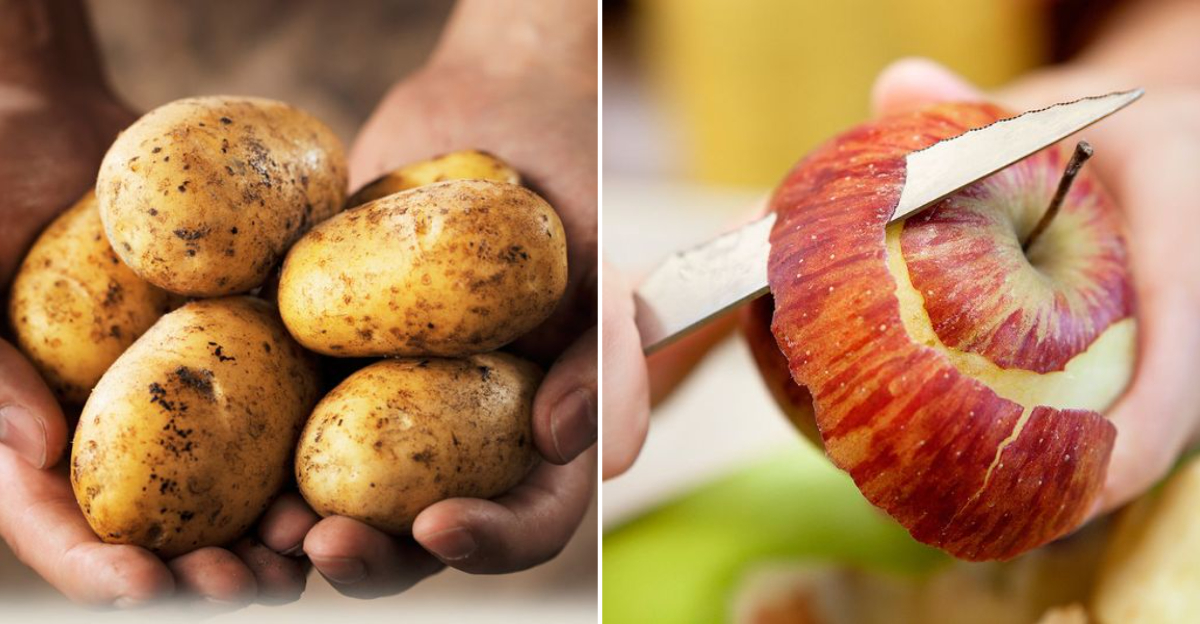11 The Most Consumed Veggie In The U.S. Is Packed With Pesticides

Ever wonder what lurks on your favorite vegetables?
I was shocked when I learned that the veggies I eat most often contain alarming levels of pesticides.
These chemicals might help crops grow abundantly, but they come with potential health risks we can’t ignore.
Let’s explore America’s most popular vegetables and the concerning pesticide residues they harbor – plus what you can do to protect yourself and your family.
1. Potatoes: America’s Favorite Veggie Has A Dirty Secret
Nothing beats a steaming baked potato with all the fixings after a long day. Growing up, my family had ‘potato Tuesdays’ – a tradition I carried into adulthood until I discovered potatoes rank high on the pesticide contamination list.
Conventional potato farming relies heavily on fungicides and insecticides since potatoes grow underground where pests thrive. Farmers typically spray the soil before planting and treat the plants multiple times throughout the growing season. What’s worse? Potatoes absorb these chemicals through their thin skins.
Switching to organic potatoes reduced my exposure to these harmful substances. Another option? Try sweet potatoes, which typically require fewer pesticides to grow successfully. If organic isn’t available, peeling conventional potatoes removes some (but not all) of the residue.
2. Spinach: The Leafy Green With A Chemical Problem
Popeye’s favorite strength-booster packs a nutritional punch, but also harbors a concerning secret. Last summer, I tossed handfuls of spinach into my smoothies daily, unaware it ranks second on the Environmental Working Group’s Dirty Dozen list.
Spinach farmers combat leaf-munching insects with up to 54 different pesticide residues detected in recent testing. The leafy structure creates numerous surfaces where chemicals can cling, making thorough washing challenging. Permethrin, a neurotoxic insecticide particularly harmful to the human nervous system, appears on spinach more than any other produce.
Now I choose organic spinach whenever possible. When that’s not an option, I soak conventional spinach in a mixture of water and baking soda for 15 minutes before rinsing thoroughly – a method research shows removes more pesticides than water alone.
3. Strawberries: The Berry With A Bitter Truth
Those juicy red berries brightening summer desserts hide an unappetizing reality. My daughter’s strawberry obsession led me down a rabbit hole of research where I discovered these fruits consistently top the Dirty Dozen list year after year.
Strawberries’ delicate nature makes them susceptible to fungal diseases, mold, and insects. Their soft, porous skin readily absorbs pesticides, while their ground-hugging growth habit exposes them to soil treatments too. Tests have found up to 23 different pesticide residues on a single strawberry sample!
Farmers often fumigate soil before planting, using chemicals that have been linked to developmental problems and certain cancers. Since washing doesn’t remove all residues, I’ve switched to organic varieties despite the higher cost. The peace of mind when my little one devours them by the handful is worth every extra penny.
4. Kale: The Superfood With A Super Problem
Remember the kale chip craze? I jumped on that bandwagon with enthusiasm, crunching away on these ‘healthy’ snacks until learning about kale’s pesticide problem. What a buzzkill for this trendy superfood!
Kale’s crinkly leaves create countless hiding spots for pesticides to nestle into. Recent testing found over 60 different pesticide residues on conventional kale samples, including DCPA (Dacthal), classified as a possible human carcinogen. The most shocking part? Kale wasn’t even on the high-pesticide list until recently, showing how farming practices evolve – sometimes for the worse.
For fellow kale lovers, I recommend choosing organic or growing your own – it’s surprisingly easy in containers! When organic isn’t an option, thorough washing with a produce wash and removing the stems can reduce your exposure to these unwanted chemical hitchhikers.
5. Grapes: Tiny Fruits With Big Pesticide Footprints
Popping grapes like candy used to be my favorite desk snack until I learned about their pesticide load. One afternoon, while mindlessly munching through a bunch, I noticed I hadn’t washed them properly – prompting research that left me stunned.
Grape cultivation involves intensive pesticide use to combat powdery mildew, moths, and other threats to these delicate fruits. Their thin skins offer minimal protection against these chemicals, which easily penetrate to the flesh inside. Testing has revealed up to 56 different pesticide residues on conventional grapes, with some samples containing as many as 15 different pesticides on a single bunch!
I’ve switched to organic grapes when my budget allows. For conventional grapes, I now soak them in a vinegar solution (one part vinegar to three parts water) for 15 minutes before rinsing thoroughly – this helps remove surface residues better than water alone.
6. Apples: An Apple A Day Keeps… Pesticides Near
That shiny apple in your lunchbox might look perfect, but at what cost? My grandfather’s orchard produced wonderfully imperfect apples, nothing like the uniformly glossy ones filling supermarket bins today.
Conventional apple production typically involves multiple pesticide applications throughout the growing season. These treatments target apple maggot flies, coddling moths, and apple scab fungus. The waxy coating that gives store-bought apples their shine actually seals in pesticide residues, making them harder to remove with simple washing.
Studies have detected more than 47 different pesticide residues on conventional apples, with some remaining even after peeling. Since apples are a daily staple for many Americans (especially children), choosing organic varieties significantly reduces your family’s pesticide exposure. When organic isn’t available, peeling conventional apples eliminates some (though not all) of the chemical residue.
7. Peaches: The Fuzzy Fruit With A Chemical Coating
Biting into a juicy peach is summer perfection – until you consider what might be lurking in that fuzzy skin. Last August, I watched my son devour a peach, juice dripping down his chin, and suddenly wondered what else he might be consuming.
Peaches’ soft flesh and delicate skin make them highly susceptible to insect damage and fungal diseases. Their fuzzy exterior creates an ideal surface for pesticides to cling to, with the fine hairs trapping residues that water alone can’t remove. Testing has found up to 62 different pesticide residues on conventional peaches, some of which are known hormone disruptors.
Organic peaches offer a safer alternative, though they’re often more expensive and have shorter shelf lives. For conventional peaches, I’ve found that gently scrubbing the skin under running water helps remove more residue than rinsing alone. Peeling is even more effective, though you’ll lose some nutrients found in the skin.
8. Cherries: Sweet Treats With A Sour Chemical Reality
Those gleaming red cherries I used to buy by the bagful have lost some of their appeal since I learned about their pesticide status. During cherry season last year, I noticed how unnaturally perfect they looked compared to the ones from my childhood.
Cherry trees are vulnerable to numerous pests and diseases, including cherry fruit flies, plum curculios, and brown rot. Conventional cherry production relies heavily on fungicides and insecticides, with some orchards receiving up to 15 different spray treatments during a single growing season. The smooth, thin skin of cherries readily absorbs these chemicals.
Testing has detected up to 42 different pesticide residues on conventional cherries, with some samples containing residues of five or more pesticides. I now choose organic cherries whenever possible, especially for my children. When organic options aren’t available, thorough washing helps – but doesn’t eliminate – residues hiding in the small crevice around the stem.
9. Nectarines: Smooth-Skinned Siblings Of Peaches Share Their Problem
Smooth, sweet, and sadly, saturated with chemicals – that’s the reality of conventional nectarines. I discovered this while pregnant and creating a ‘clean eating’ plan, when nectarines appeared high on multiple pesticide watch lists.
Unlike their fuzzy peach cousins, nectarines have smooth skin that offers even less protection against penetrating chemicals. Their thin skin allows pesticides to seep directly into the flesh, making them impossible to wash away completely. Conventional nectarine orchards typically receive multiple applications of insecticides, fungicides, and growth regulators throughout the growing season.
Recent testing found up to 33 different pesticide residues on nectarine samples, including several classified as probable human carcinogens. For pregnant women and young children especially, choosing organic nectarines significantly reduces exposure to these potentially harmful substances. Peeling conventional nectarines removes some residues but also eliminates valuable nutrients found in the skin.
10. Pears: The Pesticide Pear-Adox
Pears were my go-to fruit for my baby’s first solid foods until I uncovered their pesticide predicament. The irony of choosing what I thought was a gentle, easily digestible fruit – only to learn it ranked high for chemical residues – wasn’t lost on me.
Pear trees face numerous threats, including fire blight, codling moths, and pear psylla, leading conventional growers to apply multiple pesticide treatments. Their soft, grainy flesh and thin skin allow these chemicals to penetrate deeply. What’s particularly concerning is that pesticide residues have been detected in the core and flesh of pears, not just on the surface.
Tests have found up to 49 different pesticide residues on conventional pears, with some samples containing residues of five or more pesticides simultaneously. For babies and young children, whose developing systems are especially vulnerable to these chemicals, organic pears provide a safer alternative. When organic isn’t available, peeling conventional pears removes some (though not all) of the residue.
11. Berries Beyond Strawberries: Blueberries And Blackberries Hide Chemical Secrets
Those antioxidant powerhouses I sprinkle on my morning oatmeal come with an unwelcome addition. Last month, while making a berry smoothie, I realized I knew nothing about pesticide levels in my favorite blues and blacks.
Both blueberries and blackberries face significant pest and disease pressure, from fruit flies to fungal issues. Their small size creates a high surface-area-to-volume ratio, potentially concentrating pesticide residues. Conventional blueberry production often involves soil fumigation before planting and multiple pesticide applications throughout the growing season.
Recent testing found 13 different pesticide residues on conventional blueberries and 14 on blackberries, including fungicides linked to hormone disruption. The clustered structure of blackberries creates numerous crevices where pesticides can hide, making thorough washing difficult. For these reasons, I’ve switched to organic berries, especially since we consume them with the skin on and often feed them to children.
